|
 Home: PCU 4|2004: Leonard G Gomella, MD Home: PCU 4|2004: Leonard G Gomella, MD

 |
Overview of Adjuvant and Neoadjuvant Endocrine
Therapy for Prostate Cancer |
 |
Leonard G Gomella, MD |
| 1.1 |
|
| |
|

SLIDE 1.1 While we tend to focus on PSA recurrence rate, unless adequately treated with localized therapy, prostate cancer can be a lethal disease. This was elegantly described by Peter Albertson several years ago: If you evaluate a series of men from 55 to 74 years of age, the chance of dying from prostate cancer, managed conservatively, is quite high in patients with higher Gleason scores. Clearly, we’re not just talking about the potential for PSA progression. These cancers can be lethal if not treated properly.
The turning point in this area was brought forth by Anthony D’Amico and his colleagues at the University of Pennsylvania, who published a paper in JAMA about four years ago in which they specifically evaluated risk stratification in patients with localized prostate cancer treated with curative intent. They evaluated the outcomes of patients treated with monotherapy using radical prostatectomy, external beam radiation therapy or implant therapy. Some patients were treated with combined therapy.
Based on PSA progression, those patients with low-risk disease who were treated with monotherapy, did fairly well. However, the patients with high-risk features — high Gleason score, high PSA, advanced clinical stage — regardless of the treatment but particularly those treated with monotherapy, uniformly did poorly based on PSA progression. Patients at low risk were defined as those who had less than a 25 percent risk of PSA failure at five years.
These patients had low clinical stages, Gleason scores of six or less and PSAs less than 10 ng/mL. The troubling cases are those patients who have greater than a 50 percent progression rate based on PSA failure, and those with more bulky tumors and higher Gleason scores, particularly in the range of 8 to 10.
|
| |
|
|
| |
|
|
| 1.2 |
|
| |
|

SLIDE 1.2 The bottom line in risk stratification today is that patients at low risk appear to have similar outcome with any monotherapy, but it’s the patients at high risk who tend not to do well with monotherapy, and combination therapies may be appropriate to consider at this point in time.
We’re moving forward rapidly in this area, and we’re getting more and more sophisticated and more and more specific with how we can assess risk in an individual patient with prostate cancer. By doing risk assessment of an individual patient, we may be able to tailor treatment for them more precisely and improve their final outcome.
|
| |
|
|
| 1.3 |
|
| |
|
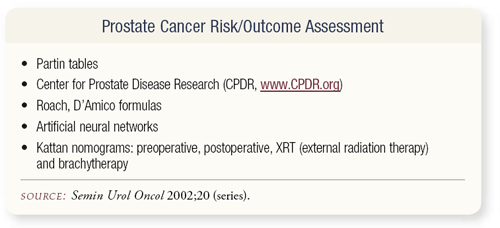
SLIDE 1.3 Most urologists are familiar with the Partin tables. Dr Moul’s group at the Center for Prostate Disease Research in Washington has a website that can be used to enter multiple parameters.
Dr Roach and Dr D’Amico developed their own formulas. David Crawford, Dr Gamito and others have been active in the area of artificial neural network. Mike Kattan, who started this work when he was in Texas and is continuing at Sloan-Kettering in New York, has developed a whole series of nomograms, which are particularly useful for a variety of patients, both preoperatively and postoperatively.
The nomograms have been expanded to assess risk of patients treated by external beam radiation therapy, 3-D conformal therapy, and brachytherapy.
|
| |
|
|
| 1.4 |
|
| |
|
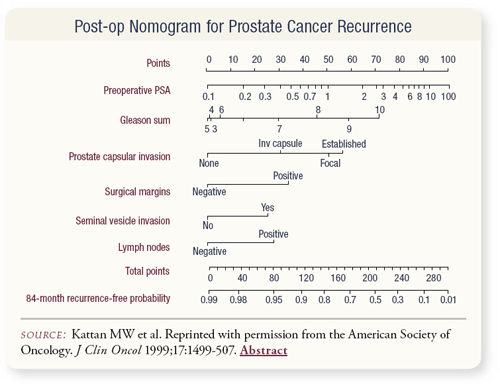
SLIDE 1.4 This is an example of one of the early postoperative nomograms in manual format that everyone has become familiar with. Individual parameters are each assigned a point, and the points are added together for a seven-year recurrence-free probability. These can be customized for each patient and are very specific for the unique parameters of the individual patient.
|
| |
|
|
| 1.5 |
|
| |
|
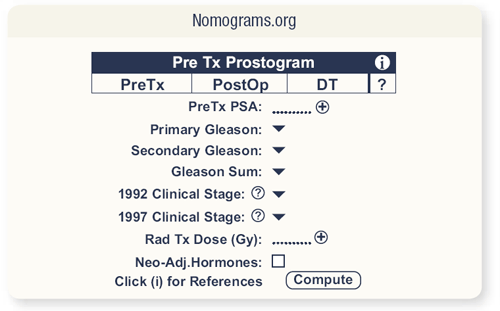
SLIDE 1.5 Nomograms are now available via the Internet at nomograms. org, where anyone can log in and receive instructions on how to download a Palm-friendly, Windows-CE-friendly or desktop-friendly format. Users can enter specific criteria and determine the risk of a patient having progression after definitive local therapy.
|
| |
|
|
| 1.6 |
|
| |
|
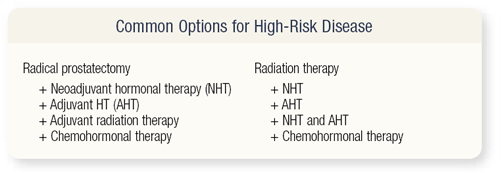
SLIDE 1.6 After having developed all of these very sophisticated tools, we face our next challenge. After we identify a patient at higher risk of progression or failure after definitive local therapy, what do we do for them? This is an evolving and rapidly progressing area of research. The improved outcomes, particularly when it comes to survival in prostate cancer, may be due to some of new multimodality therapies that are being applied to patients with high-risk disease.
If we identify a patient with high-risk disease, performing a radical prostatectomy (RP) is an option, but we will focus on combined therapy, evaluating neoadjuvant hormonal therapy (NHT) and adjuvant hormonal therapy (AHT) to improve the outcome of these patients. Adjuvant radiation therapy (RT) and chemohormonal therapy are also options, but the focus of our discussion will be endocrine manipulations. If you plan on treating a patient at high risk with radiation therapy, the hormonal approaches — other than dose escalation, which has been proven to help a little bit — include neoadjuvant or adjuvant hormonal therapy. In radiation therapy the approach receiving the most attention and the most positive outcome is the combination of neoadjuvant and adjuvant hormonal therapy.
|
| |
|
|
| 1.7 |
|
| |
|
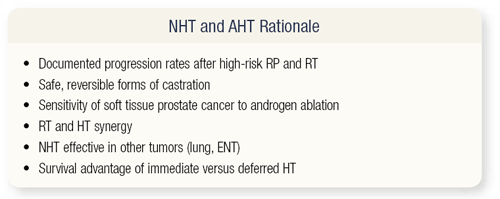
SLIDE 1.7 The rationale for combined neoadjuvant and adjuvant hormonal therapy is that we have documented progression rates in patients with high-risk disease treated with monotherapy by radical prostatectomy (RP) and radiation therapy. Safe, reversible forms of castration are now available to us. We know that soft-tissue prostate cancer appears to be much more responsive to androgen ablation than bony metastatic disease. The synergy between radiation therapy and hormonal therapy (HT) has been well documented in animal studies and in several important clinical trials.
The concept of neoadjuvant hormonal therapy has been proven to be efficacious in other tumor systems, such as in lung and head and neck cancers. Evidence strongly suggests that in patients with highrisk localized disease, immediate hormone therapy offers an absolute survival advantage over deferred hormonal therapy.
|
| |
|
|
| 1.8 |
|
| |
|
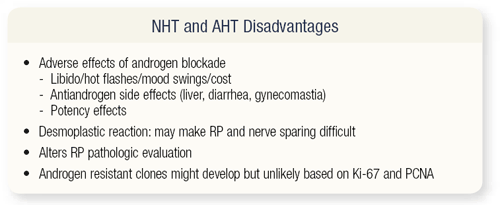
SLIDE 1.8 Having said that, are there any downsides to neoadjuvant and adjuvant hormonal therapy? Certainly, we have to realize it is a doubleedged sword, and we may have some problems with these treatments. The adverse effects of androgen blockade may include problems with libido, hot flashes and mood swings, and these therapies are more costly. Antiandrogens, either as monotherapy or combined therapy, have a unique side-effect profile involving liver toxicity. Some agents have the potential to cause diarrhea or gynecomastia. Occasionally, neoadjuvant monotherapy causes a very pronounced desmoplastic reaction that may make a nerve-sparing prostatectomy more challenging. Neoadjuvant therapy before radical prostatectomy significantly alters the final pathologic evaluation, and that must always be considered.
A theoretical concern exists that treating patients who have localized disease with androgen ablation may cause or stimulate the development of androgen-resistant clones; however, based on extensive basic science studies of Ki-67 and PCNA assays, at least in the short term, it’s unlikely that using these approaches causes the development of androgen resistance.
|
| |
|
|
| 1.9 |
|
| |
|
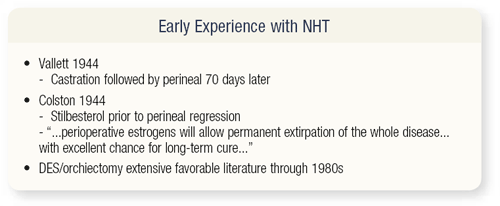
SLIDE 1.9 Neoadjuvant and adjuvant hormonal therapy are concepts that are over 60 years old. The very first description of neoadjuvant hormonal therapy dates back to 1944, when Drs Vallet and Colston and other surgeons reported using castration or estrogens before perineal prostatectomy with fairly favorable outcomes. DES and orchiectomy were used extensively through the 1980s, but more advances in this area really occurred in the 1990s.
|
| |
|
|
| 1.10 |
|
| |
|
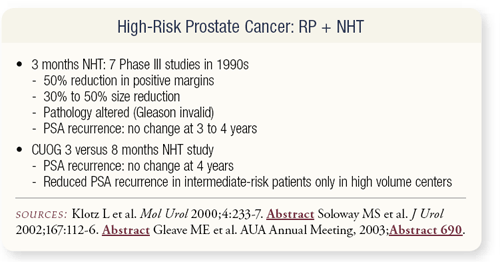
SLIDE 1.10 In the 1990s, at least seven Phase III trials evaluating neoadjuvant hormonal therapy and radical prostatectomy were reported, and all demonstrated a 50 percent reduction in positive margins in general. They confirmed that the pathology was significantly altered, and the Gleason score would not be valid if neoadjuvant monotherapy was utilized.
The bottom line of these studies was that no change in PSA recurrence was observed. One thought was that perhaps these threemonth studies were of insufficient duration to provide the full androgen-withdrawal effect on the prostate.
The Canadian Urologic Oncology Group (CUOG), after some pilot studies, performed a study of a three versus eight months that was reported last year by Dr Gleave. A small cohort of patients at intermediate risk who were treated at high-volume centers had a reduced incidence of PSA recurrence at four years follow-up, but overall no significant change in PSA recurrence was observed. We’re waiting to see more follow-up from this study.
|
| |
|
|
| 1.11 |
|
| |
|
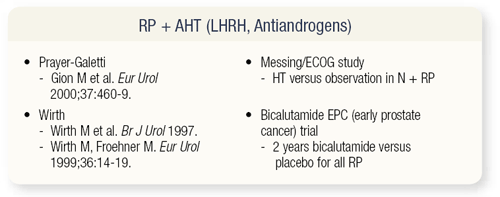
SLIDE 1.11 What about performing radical prostatectomies and adjuvant hormonal therapy? A series of studies exist. Some of the key studies include Dr Messing’s ECOG study and Dr See’s bicalutamide early prostate cancer trial, which suggest that using adjuvant hormonal therapy with radical prostatectomy offers some significant advantages.
|
| |
|
|
| 1.12 |
|
| |
|
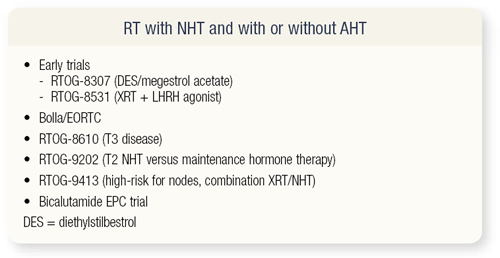
SLIDE 1.12 What about radiation therapy with neoadjuvant or adjuvant hormonal therapy? The radiation oncologists have been very progressive in this area and have been conducting trials for over 20 years. They have brought forward some significant, large, prospective, randomized clinical trials of combination therapy, including trials of patients with T3 disease, T2 disease and patients at high risk for having positive nodes. Bicalutamide has also been evaluated in the EPC trial, along with radiation therapy.
|
| |
|
|
| 1.13 |
|
| |
|
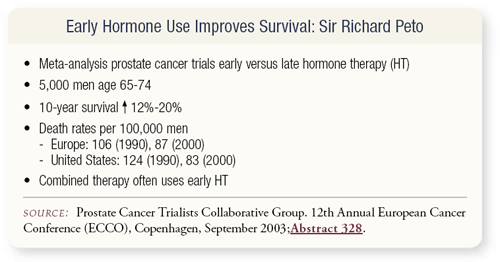
SLIDE 1.13 Sir Richard Peto performed a meta-analysis in which he examined a large number of patients treated with early versus late hormonal therapy. The bottom line was that he believed the significant increase in the 10-year survival rates, both in Europe and in the United States during the 1990s — an increase of anywhere from 12 to 20 percent in absolute survival —could possibly be from the early use of hormone therapy.
|
| |
|
|
| 1.14 |
|
| |
|
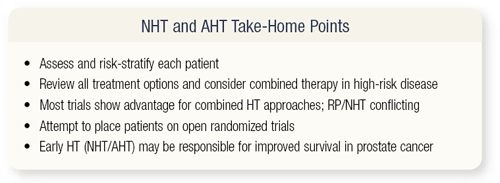
SLIDE 1.14 As we move forward with neoadjuvant and adjuvant hormonal therapy, it is very important to assess the risk of progression in each patient treated for localized disease. It’s important to review all the treatment options with the patient and, if you have a patient with high-risk disease, consider some type of combined therapy that may or may not include hormones or radiation therapy. Most randomized trials have demonstrated an advantage for combined hormonal therapy. As we noted, the radical prostatectomy/neoadjuvant hormonal data is conflicting. It’s very important to always try to enroll patients on open randomized clinical trials. Lastly, it is possible that the early use of hormonal therapy — neoadjuvant and adjuvant hormonal therapy — may be responsible for the improvement that we’re seeing in prostate cancer survival over the last decade.
|
| |
|
|
Select publications
|
|
|
|
|
|
|
|
|
|